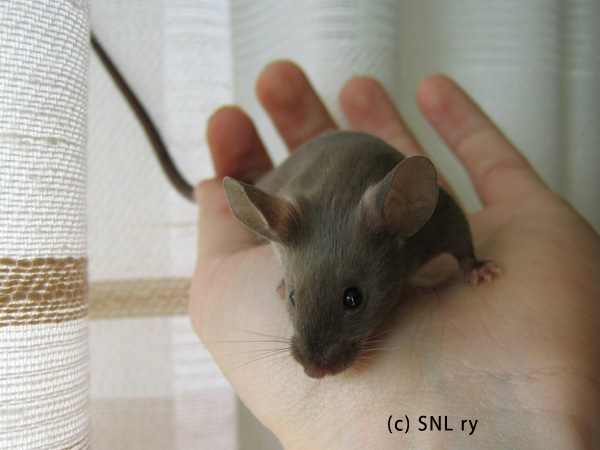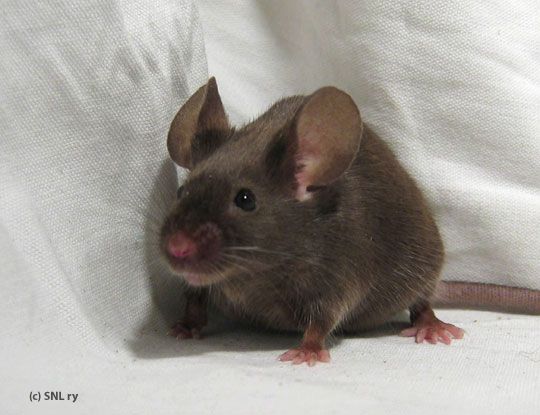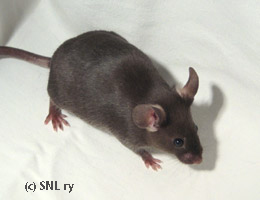Varieties
Shaded and Pointed
Burmese (bur)
a/a B/* cch/ch D/* P/*
"Eyes black. The burmese is to have light chocolate body colour all over. The points, which are very dark brown, almost black, are like with the siamese."
Breeding information below the pictures.
Quick Look
Burmese is one of the pointed varieties without shadings. It can be likened to a himalayan with a light chocolate-y body instead of a white one and very dark chocolate points. Most common faults on a burmese is too small a difference between the body and the point colours, making the points not show properly. Even though the colouration of a burmese is chocolate brown in two different shades, it is not the warm deep brown of a chocolate mouse. That's because of the effect of c-locus recessives on red, warmth giving pigment.
On some standards this variety is called "siamese sable". The Finnish Mouse Club decided not to use that term and chose burmese instead for two reasons: 1) people felt "siamese sable" to be a misleading name, implying either genetic similarity with sable or a mouse with combined shadings of a siamese and a sable, and 2) Finnish gerbil club had named a similar enough looking variety "burmese", so nicking the name for mice was easy.
Genetic Background
In genetic terms burmese is a self black mouse with two different recessives in the c-locus: one chinchilla and one himalayan. As with other varieties heterozygous with himalayan ch, burmese has points but no shadings. C-locus (officiallly "tyrosinase") is located at choromosome 7 and the "burmese making genes" are officially called Tyrc-ch (tyrosinase; chincilla) and Tyrc-h (tyrosinase; himalayan), which are both old spontaneous mutations. Chinchilla was first reported in 1922, himalayan in 1959.
Self black mouse turns into one with light chocolate body due to the combined diluting effects of chinchilla and himalayan: chinchilla turns black into mock black/chocolate (sepia), himalayan into one a white mouse with only the extremities pigmented. With a burmese, the end result is a body colour somewhere in between these two in body colour. The points come from himalayan's effect on pigment formation, where the coldest parts of the mouse has more pigment.
Due to its genetic background, burmese doesn't breed true. This is because the variety is heterozygous in c-locus. Burmese x burmese matings always results in other varieties as well: statistically speaking 2/4 burmese, 1/4 siamese and 1/4 sepia.
In More Practical Terms
Burmese has never been a popular variety, partly due to the common problem of points not showing that well. As the darkness of body colour can be affected in siameses with selectively breeding suitable modifiers (see example photo of shade difference in ssp), it is logical to think the same thing applying to burmese. For breeding burmeses, it's useful to pick siameses with good, dark points but as light a body as possible.
In the practice of breeding, the most suitable combination is burmese x burmese, paying attention to the development of body and point colours. In order to strenghten points, the best outcross is a siamese with above mentioned colouration.
Burmese has a tendency to darken with age and this is something a breeder is adviced to pay attention to. Burmese isn't that good an outcross for other varieties, unless you are intending to breed blue burmese by starting out with burmese x siamese blue point crosses.
Starting From Scratch
In order to get burmeses, you need to get chinchilla and himalayan dilutions into a self black mouse. The himalayan gene is easily available from siamese seal point, but the chinchilla part can be trickier.
If there are no burmeses around, try looking for blue burmese. Crossing bl-bur with a ssp you'll get burmeses in the first generation.
If there aren't blue burmeses, you need to look elsewhere for the chinchilla gene cch.
Best possible option is a sepia. Sepia is a self black mouse with a double dose of chinchilla gene in c-locus. The colour is dull, poor black / dark chocolate without the warmth of the self chocolate mouse's colour. Sepias may crop up in chinchilla, grey agouti and black fox breeding programs, so ask around from breeders of these varieties. Breeding a sepia mouse to siamese seal point will give you a whole litter of burmeses.
Unlike one might thing, a chinchilla isn't that good an option for obtaining cch. First of all, chinchillas have either white-bellied agouti Aw or black-and-tan at in a-locus (or both), and you really do not want white bellies into your burmeses. Better, but not good, option would be a grey agouti, but that too brings in problems: the agouti gene A. Agouti version of a burmese looks like a brown grey agouti and doesn't have that much points. It really isn't a pretty variety.
You could also get the chinchilla gene from black/blue/chocolate/lilac fox, but you'd also get the problematic white bellies.
What you get from your first siamese x cch/cch cross depends on what variety you are trying to get the chinchilla from. If the original cross is siamese (a/a B/* ch/ch D/*) x grey agouti (A/* B/* cch/cch D/*), you'll get a litter of non-agouti carrying ticked "agouti burmeses". (With luck, the grey agouti had A/a and with some more luck you'll end up with burmeses in the first generation.) When two of these mealy burmeses are mated together, you will get some burmeses (with the needed a/a) and other colours including siameses, mealy agoutied siamese, chinchilla, grey agouti and sepia.
If you are desperate for burmese and the only way of getting the chinchilla gene is a black group fox (NOT from one that is beige or bone fox, as these two varieties do not have cch, as their white bellies are due to extreme dilution ce!). Mate the fox (at/* cch/cch) with the seal point siamese (a/a ch/ch) and you will get burmese. Some of them are foxes. If the fox had a double dose of the tan gene, all of the young from this first cross will be foxed. Mating them together should give you proper burmeses. It is easier if you choose not to use the foxed burmeses in your breeding.




